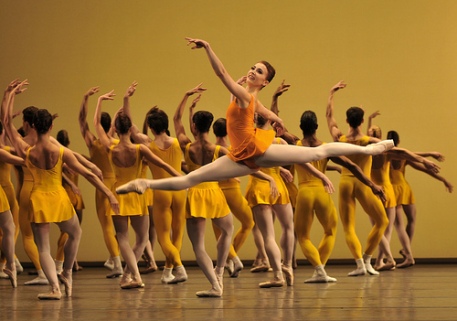I have long been an ardent and vocal devotee of Mr. Balanchine; his ballets excite me like those of no other. However, the recent Royal Ballet triple bill of Sir Kenneth MacMillan’s work is a fitting homage on the 20th anniversary of his tragic death, but more importantly, a reminder of the real extent of his genius.
More closely associated with his full length ballets – Romeo and Juliet, Manon, Mayerling – than his shorter works, it is in these less renowned one-acters that his artistic range is really evident. The strictly academic, but utterly joyous Concerto; the dark and unsettling Las Hermanas; the elegiac and uplifting Requiem. Three completely different ballets, not only in content, but in style, mood and intent. The one unifying factor is MacMillan’s thorough knowledge and reverence for the classical technique, and moreso, how it can be employed to achieve a huge range of emotional states.
Claire Calvert in Concerto (courtesy of DanceTabs)
Concerto, with it’s wonderful military-flavoured Shostakovich score, is closely related to some of the works of Balanchine in its minimal aesthetic. Unlike Balanchine, MacMillan savours the conventions of the classical form, rather than reinventing them. The bouyant opening and closing sections sandwich what must rank as one of the most beautiful adagio movements in the neoclassical repertoire. Las Hermanas, a distillation of Lorca’s The House of Bernarda Alba, is more traditional MacMillan territory; can any other choreographer confidently portray sexual violence or despair through the medium of classical dance? Requiem is at the far end of MacMillan’s vast repertoire – his homage to colleague and friend John Cranko, set to Fauré’s work of the same name. While it is overtly religious, it still remains abstract – any narrative being personal to the viewer. It is one of those work sthat leaves one breathless, the interpretation of the music being so pitch-perfect.
There have been many choreographers over the decades that can match MacMillan in both popularity and work-rate, but this triple bill is just one incidence that confirms that none of his choreographer-contemporaries quite makes the mark when it comes to range. Balanchine cornered the market for abstract ballets to be sure, Tudor was the master for ballets which delve into the psyche and Ashton and Robbins were his equal for sumptuous, breathtaking beauty; but no one else can claim to be as adept at all three. And 20 years on still there is no one. All hail.

